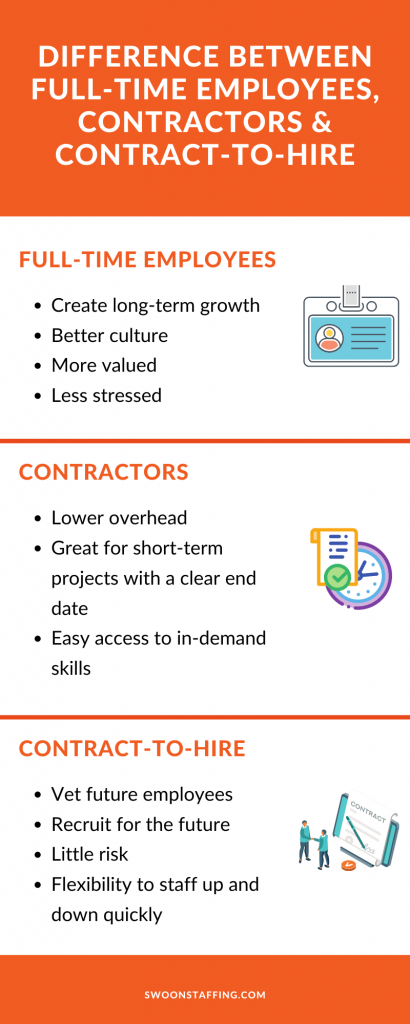
Direct Hire vs. Contract Employees – Which one is going to be best for you and your company?
Written in conjunction with Joe Matalone – Executive Vice President, Chris Thrall – Director of Talent Solutions and Colin Harris – Business Development Lead.
With many companies starting to kick up their hiring initiatives again, they need to figure out the best hiring process for their company.
Since COVID-19 left many furloughed, the talent pool has grown substantially. Something that we haven’t seen in years. Below, we will discuss direct hire, contract-to-hire and temporary processes and the best situations in which to use them.

Recap of Definitions
Direct Hire Placement: A staffing agency adds permanent staff directly to another company’s payroll.
Temp Staffing: A candidate is hired as a solution for unpredictable workloads, project work, seasonal peaks and other short-term needs such as a leave of absence. They are employed by the staffing agency and all positions have an established timeframe.
Contract-to-Hire: The selected candidate begins their employment contract on the staffing agency’s payroll, not the client’s. They are placed in a short-term position for a set period, with the possibility of being hired as a full-time employee at the end of that contract.
Advantages
Direct Hire:
- The candidate is sourced as a full-time employee from day one. This allows you to avoid the annuity costs associated with contract/contract-to-hire employees and your new hires feel that they are part of the team right away.
- Direct hire roles are more attractive to passive candidates. Thus, allowing you to see a higher number of highly qualified candidates.
- This is evident because you can offer better perks and benefits packages to attract the type of prospective candidates you are looking for.
- Typically, there is stronger employee commitment. These employees often have a better sense of stability and security within the company that they are placed in.
Contract/Temp Employees:
- Saves your company time and money. These employees allow you to get the help that your company needs quickly without the cost and effort of recruiting and hiring full-time staff members.
- Offers flexibility by helping companies fill openings quickly that are caused by seasonal demand or employee absence. This way, companies can meet demands while not overstaffing or requiring current team members to take on more tasks.
- You can tap into skills that you currently don’t have inhouse. This way, you can quickly complete projects that your current team members don’t have the skills or experience.
Contract-to-Hire:
- The ability to experience a trial run. You can “try before you buy” and minimize the risk of an employee not being a fit long-term.
- There is more budget flexibility.
- These positions can give a company the time to work a new full-time employee into the budget while still getting the work done.
- Contract-to-hire employees are typically not eligible for benefits until they become a full-time employee. However, in most cases, they get the option of receiving benefits through the staffing agency they are working with.
- The employees are typically only paid on an hourly basis for the specific hours worked rather than a fixed salary.
- You can save on specialized skills that you don’t already have in-house. Contractors can help you complete projects that require skills and experience that your full-time staff doesn’t already have.
- Contract-to-hire can help you accommodate growth. We can’t always predict when growth or expansion needs to happen, and this can be extremely difficult for your full-time employees to take on additional work themselves when they have a full workload already. During these times, you can leverage contract staffing to complete the necessary extra work.
How Does Contract-to-Hire Work?
When you use a staffing agency to fill contract-to-hire positions, they will handle many of the front-end recruiting tasks, such as:
- Sourcing candidates
- Reviewing resumes
- Conducting initial screenings
Once a candidate has moved through these stages, they will be passed along to the client for final interviews. The company will then make the final decision with insights and guidance from the staffing agency if needed. Once a candidate is selected and accepts an offer, they will begin their employment contract on the staffing agency’s payroll rather than the client’s.
The duration of these contract-to-hire positions varies from one month to being indefinite. However, they will usually run from three to twelve months. In most situations, the client will have the opportunity to convert the contractor to a full-time hire in a manner that meets their needs.
Why Would a Company Dismiss the Idea of Hiring a Contractor?
When it comes to a company dismissing the idea of hiring a contractor, a few things come to mind.
- Contractors can be more expensive than hiring a full-time employee, depending on the situation.
- It’s more cost-effective to pay for a full-time employee than a contractor if you are going to keep them on for 2-3 years in some cases.
- Operating expenses (OPEX) are the cost of doing business, such as employee wages, utilities, insurance, and rent required for the day-to-day functioning of a company (including employee wages). In contrast, a capital expense (CAPEX) is an expense that a business incurs to create a benefit in the future (such as an IT project to upgrade a system that could require contractors to come in and complete that project). OPEX and CAPEX are treated quite differently for accounting and tax purposes and could be the reason for hiring one over the other.
- Companies don’t want to lose intellectual property. However, as a company hiring a contractor, you can have a written agreement executed before the commencement of the employment relationship. This agreement can assign to the company any and all intellectual property created by the employee during their employment with the company.
- Companies don’t have a history of hiring contractors and are unaware of the process – this is where we can come into play and help you understand the best path for your needs.
- Companies have budgetary challenges and might not be able to afford the contractor fees on top of the full-time employee fees if they choose to hire after the contract is up.
- Employees miss out on getting proper integration into the company culture.
- A company is challenged to bring in revenue, thus putting projects on hold that they could bring in a contract-to-hire to complete.
Why is Direct Hire Skyrocketing During COVID-19 and Not Contract-to-Hire?
At the beginning of this recession, we thought that we would see an increase in contract-to-hire over direct hire placements. When asked, Joe Matalone – EVP, had a great response to why he believes that direct hire placements are skyrocketing now.
“I think we can find our answers here in analyzing the U.S. stock market and employment data at the beginning, middle and present times of COVID-19.
Beginning of COVID-19: What we saw in the very early days of COVID was simply confusion at all levels as it came at us so quickly – which frankly jolted the global markets. Millions were furloughed during the pandemic, with a record 20.5 million U.S. jobs lost in April. However, some companies were and still are hiring thousands of new employees to keep up with shifting consumer demands and spending habits. That being said, some employers may have cut too deeply (particularly in the departments of Talent Acquisition) and have now realized that they need to hire again and hire quickly to maintain any competitive edge. Suddenly, there is a fresh wave of talent that the employers have not seen in many years due to the historical run of strong overall employment numbers.
Present Day: Fast forward to the present; it feels like the market is tightening again in specific skillsets, most notably in digital and technology, which were more resilient to the downturn. It’s almost as if we’re not in a recession any longer.
Final Thoughts: I think this will be the fastest end to a recession ever! Some areas of the market will take longer to recover, such as travel/retail/hospitality. Some employees that had been placed on leave, laid off, or maybe not treated so nicely during the last few months are looking and have options. You add in the embracement and acceleration of hiring remote workers now, and the talent pool gets very large.
During economic downturns, candidates are unwilling to leave their current “permanent” position for anything but a direct-hire position. When the country is in the middle (or hopefully tail end) of a pandemic, benefits such as health insurance are top-of-mind for everyone.”
Joe Matalone – EVP at Swoon
Conclusion
It’s important that you take a look at what is best for your company at that time. What works for one company might not necessarily work for yours. Will your company benefit more from having a direct-hire placement for a full-time employee, a temporary contractor or a contract-to-hire so that you may “try before you buy”? There is no right or wrong answer. It all just comes down to what you think will be the best, and if you have any questions along the way, we are always here to help!

